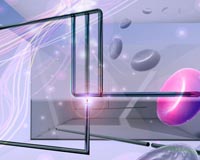 |
Karnataka, India (SPX) May 31, 2010 Writing in the International Journal of Nanoparticles, Rani Pattabi and colleagues at Mangalore University, explain how blasting silver nitrate solution with an electron beam can generate nanoparticles that are more effective at killing all kinds of bacteria, including gram-negative species that are not harmed by conventional antibacterial agents. Your running shoes, socks and even computer keyboard may be impregnated with silver nanoparticles that can kill some bacteria, keep you smelling sweet and preventing the spread of infection among computer users. Researchers in India point out that silver nanoparticles are not only antibacterial against so-called gram-positive bacteria, such as resistant strains of Staphylococcus aureus and Streptococcus pneumoniae but, also against gram-negative Escherichia coli and Pseudomonas aeruginosa. Bacterial resistance to conventional antibiotics is threatening human health the world over. Medicinal chemists are desperately trying to develop new compounds that can kill strains such as MRSA (methicillin, or multiple-resistant Staphylococcus aureus) and E. coli O157. Frontline defenses, such as environmentally benign and cost-effective antibacterial compounds could prevent such infective agents spreading through contact with computer keyboard, phones and other devices. Silver has been known to have antibacterial properties since ancient times. A modern technological twist means it has come to the fore for a wide range of applications because of the emergence of resistance to antibacterial gels. As such a new industry involving the production of bacteriostatic agents, including silver nanoparticles, has emerged. Researchers have been experimenting with radiation to split silver compounds, releasing silver ions that then clump together to form nanoparticles. The incentive lies in the fact that such an approach avoids the need for costly and hazardous reducing agents and can be fine-tuned to produce nanoparticles of a controlled size, which is important for controlling their properties. Pattabi and colleagues have used electron beam technology to irradiate silver nitrate solutions in a biocompatible polymer, polyvinyl alcohol, to form their silver nanoparticles. Preliminary tests show that silver nanoparticles produced by this straightforward, non-toxic method are highly active against S. aureus, E. coli, and P. aeruginosa. "Antibacterial potential of silver nanoparticles synthesised by electron beam irradiation", in Int. J. Nanoparticles, 2010, 3, 53-64
Share This Article With Planet Earth
Related Links International Journal of Nanoparticles Nano Technology News From SpaceMart.com Computer Chip Architecture, Technology and Manufacture
 New Nanoscale Electrical Phenomenon Discovered
New Nanoscale Electrical Phenomenon DiscoveredAnn Arbor MI (SPX) May 20, 2010 At the scale of the very small, physics can get peculiar. A University of Michigan biomedical engineering professor has discovered a new instance of such a nanoscale phenomenon-one that could lead to faster, less expensive portable diagnostic devices and push back frontiers in building micro-mechanical and "lab on a chip" devices. In our macroscale world, materials called conductors effect ... read more |
|
| The content herein, unless otherwise known to be public domain, are Copyright 1995-2010 - SpaceDaily. AFP and UPI Wire Stories are copyright Agence France-Presse and United Press International. ESA Portal Reports are copyright European Space Agency. All NASA sourced material is public domain. Additional copyrights may apply in whole or part to other bona fide parties. Advertising does not imply endorsement,agreement or approval of any opinions, statements or information provided by SpaceDaily on any Web page published or hosted by SpaceDaily. Privacy Statement |